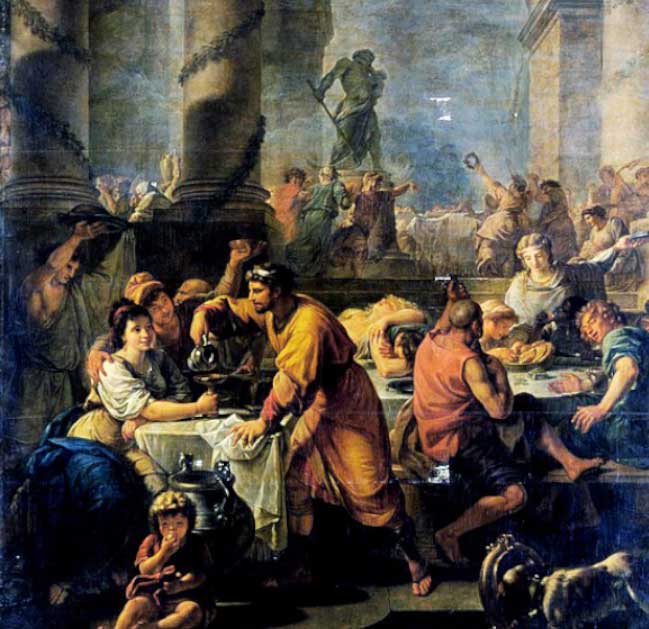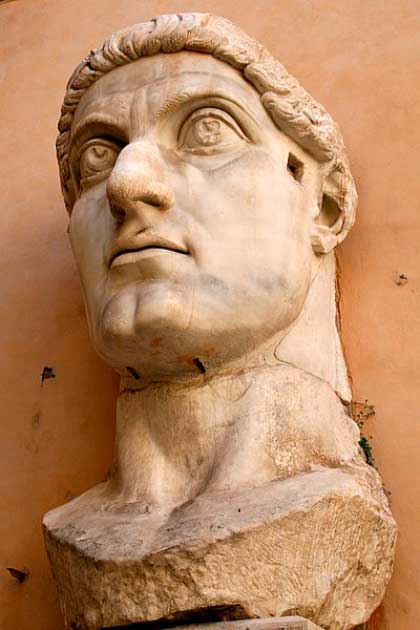The term paganism has always been something of an insult. First recorded in the fourth century by early Christians to describe individuals within the Roman Empire who practiced polytheistic or ethnic religions (other than Judaism), it was meant to an once lump all minor religions under one banne, and to dismissive reject them.
People who were described as pagans were individuals who lived in very rural areas away from any significant Christian population, and included anyone who didn’t consider themselves a soldier of Christ. In the Middle Ages, the term pagan became associated with a presumed belief in false gods or practiced uncivilized cultural traditions like feasts, rituals, sacrifices, and whatnot.
As Christianity began to enforce conversion, many pagan places of worship were destroyed. Christian holidays started to occur during pagan celebrations, absorbing many of the customs of the non-Christian celebrations. The best example of Christianity absorbing the traditions of pagans today is the similarities between Christmas and the pagan festival of midwinter.
Midwinter
Midwinter is the celebration of the winter solstice and the return of spring. Many different peoples and cultures in history have celebrated the festival. Midwinter is known as Yule or Saturnalia, and the traditions differ depending on where you are in the world and your culture.
Yule, Saturnalia, and the winter solstice are all celebrating the same thing, and the term midwinter is an umbrella term for this event. Essentially it was a triumph of survival and endurance amidst the darkest period of the year.

Some peoples who celebrated midwinter include the Germanic People, Anglo-Saxons, Northern Europeans (Sweden, Denmark, Norway, Iceland), Celtic Druids, and the Romans. Due to the spread of Christianity in the first century AD, many of the traditions and customs of midwinter can be observed in how Christmas is Celebrated today.
In Ancient Rome, midwinter was known as saturnalia, and people would travel to the Temple of Saturn to worship and celebrate the end of winter. Saturn was an ancient Roman god who ruled over abundance, generation, agriculture, “periodic renewal and liberation,” and time.
The celebration of Saturnalia pays honor to Saturn and aligns with the winter solstice, the shortest day and longest night of the year. This midwinter celebration came with many traditions like decorating the home with greenery and wreaths, singing, gambling, and making music with others.
Midwinter for the Romans also included the practice of giving gifts to others. Saturnalia was a week-long festival, and on the final night, loved ones and friends would give each other terracotta figurines called signillaria.
It is believed that the gifting of signillaria is a reference to the “old days,” when celebrations often involved human sacrifice. Some families or households would select a person to be a pretend king who would rule over the festivities.
- The Christmas Truce of 1914: When War Paused for Christmas
- Who Wrote “‘Twas the Night Before Christmas”?
The pretend king was called the Saturnalicius Princeps (the Leader of Saturnalia). Other families would select a “Lord of Misrule ” instead of a king; this person was either the youngest in the home or the person known to be the biggest troublemaker. The Lord of Misrule was then responsible for “making mischief during the celebrations – insulting guests, wearing zany clothes, chasing around the women and girls, etc.”
Germanic Midwinter
Midwinter celebrations outside of Rome were known as Yule. This festival celebrated the rebirth/return of the sun and gave tribute to the god Odin. Norse peoples believed that at midwinter, the god Odin would fly or ride his horse across the sky during the longest night of the year to deliver blessings or curses for the new year.
Children would fill their boots with straw and place them outside the door or on the windowsill for Odin. The god would give the children little gifts either in the shoes or place the gifts near the hearth.
Yule typically lasted 12 days; the final night, the solstice, was the largest celebration of the 12 days. The Germanic/Saxon/Scandinavian peoples would light fires to represent and celebrate the return of the light and warmth of the sun.
They would sit around the fire, telling stories, eating, drinking, playing music, and socializing. Boar or goat was usually roasted for the family or the village. Which scholars believe was symbolic of the sacrifice of animals to the gods in the old days, but it is not confirmed.
It was tradition to go into the forest and chop down a large tree that would be brought back to the village or home and was kept ablaze the entire 12 days of Yule. The tree was called a yule log.
A Feast in the Darkest Hour
Midwinter, no matter who celebrated it, shared many traditions for the festival. Greenery and wreaths of certain kinds of plants and trees were brought into the home and used as decoration, a tradition which survives to this day with decorations of holly, ivy and mistletoe: all plants which remain green in December.

Evergreens were representative of everlasting life, and wreaths were made of evergreens to represent the Wheel of Life. They would be hung on doors or placed on a flat surface and decorated with candles.
The druidic peoples worshiped mistletoe in particular and believed it was a plant with healing and protection properties. One rule, it should never touch the earth. Because mistletoe hangs from branches, its magical properties are because the plant and its berries hang in the area between heaven and the earth.
Holly was also a protective evergreen to the druids and was used to celebrate midwinter. Holly has spiky leaves that were believed to ward off negative energies or forces. The fruit of both holly and mistletoe were believed to represent the re-birth and rising of the sun.
Vikings would decorate a tree with ruins or carved symbols on the wood, and the tree was brought into the home and burnt for 12 days. Gift-giving is a part of midwinter traditions, along with spending time with others and feasting.
- 11 Things You Didn’t Know About Christmas
- Is There Encoded Religious Meaning in the “Twelve Days of Christmas”?
Midwinter is the celebration in expectation of the coming spring, and it comes with certain colors that symbolize spring. Red represents the heat and warmth of the sun. Green is for the crops and their growth once winter ends, while gold represents the sun.
Christmas
Midwinter has had a profound impact on the Christian holiday of Christmas. Throughout Europe’s Christianization, paganism and other polytheistic religions were deemed wrong and ungodly. It is believed that the Roman emperor Constantine chose December 25th for the Christian feast and the birth of Jesus as a political move.
Constantine’s goal was to weaken pagan celebrations and direct (forcibly push) the heathens toward the light of Christianity and convert. The Bible does not mention the day, month, or season Jesus was born.

Theologians and religious scholars however believe Jesus was not born on the 25th of December but in the spring. Why? The reference to sheep and shepherds being present in the nativity story.
Many elements of celebrating Christmas come from pagan midwinter festivals. Bringing an (evergreen) Christmas tree into the home where it is decorated, and when midwinter festivities end, the tree in many places is used as firewood.
Decorating the house with wreaths and tchotchkes with holly or berries can be traced directly to midwinter. Hanging the mistletoe on a door frame and kissing underneath for luck is no different than the midwinter practices of the Celtic Druids, who would hang the sacred mistletoe in their homes, never letting it touch the ground.
Family and friends gather together, a large dinner is prepared and eaten, stories are told, and carols are sung on December 25th, which has no relation to Jesus, but which is around midwinter and carried and adopted by Christians.
Nordic children filling their boots with straw for Odin sounds a lot like the story and beliefs children have about Santa Claus. Santa is a wise older man who can know if a child is good or bad through some kind of otherworldly insight.
Santa flies through the sky on Christmas Eve in a sled led by reindeer and delivers toys and treats to the good kids and nothing or coal to the naughty kids sounds just like what Odin did in midwinter. However, leaving milk and cookies out for Santa to enjoy sounds tastier than boots stuffed with straw as an offering. Those stuffed boots? They have become stockings hung above a fireplace that Santa stuffs with goodies and toys.

The largest difference between the two festive days and celebrations is the religious aspect. Christmas is centered around religion and the birth of Christ. Midwinter, on the other hand, is centered around culture and cultural traditions.
Remove the belief that the birth of Christ was December 25th, and what you are left with is a watered-down version of midwinter. Seeing soccer moms’ minivans covered in “Keep Christ in Christmas” stickers or magnets shows how strongly the Christian faith persists when people recognize that the day for many is celebrating family rather than religious observation.
Whatever your beliefs or religions may be, everyone can celebrate midwinter at yule time and spring’s return.
Top Image: Krampus, the pagan Germanic version of Santa, betrays the pagan roots of Christmas. Source: Jessica Walsh / Adobe Stock.